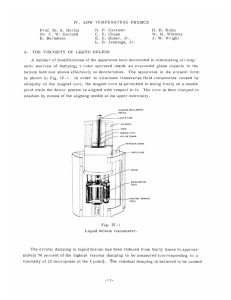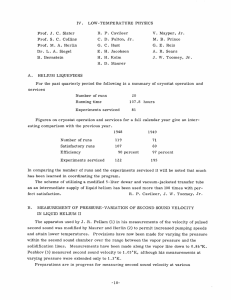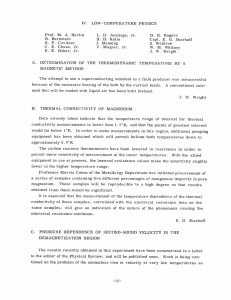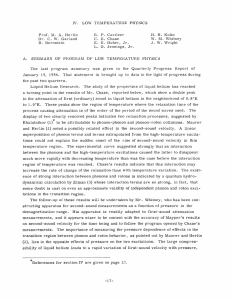IV. LOW TEMPERATURE PHYSICS H. H. Kolm E.
advertisement
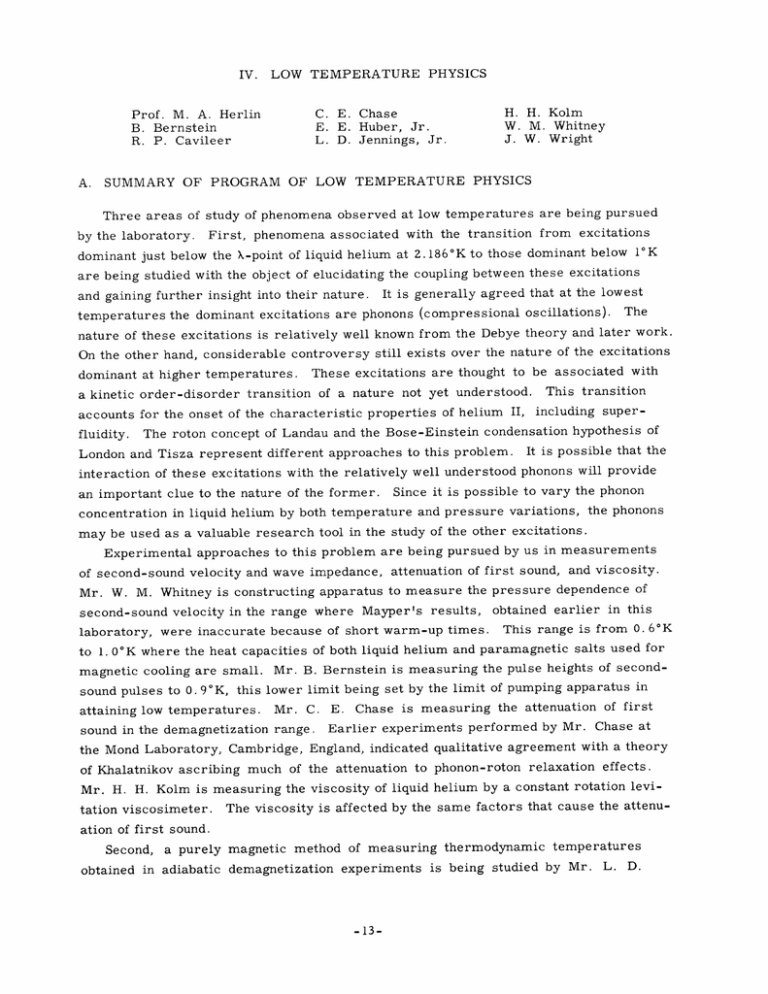
IV. LOW TEMPERATURE PHYSICS Prof. M. A. Herlin B. Bernstein R. P. Cavileer A. C. E. Chase E. E. Huber, Jr. L. D. Jennings, Jr. H. H. Kolm W. M. Whitney J. W. Wright SUMMARY OF PROGRAM OF LOW TEMPERATURE PHYSICS Three areas of study of phenomena observed at low temperatures are being pursued First, phenomena associated with the transition from excitations 0 dominant just below the X-point of liquid helium at 2. 186 K to those dominant below 1°K are being studied with the object of elucidating the coupling between these excitations and gaining further insight into their nature. It is generally agreed that at the lowest by the laboratory. temperatures the dominant excitations are phonons (compressional oscillations). The nature of these excitations is relatively well known from the Debye theory and later work. On the other hand, considerable controversy still exists over the nature of the excitations These excitations are thought to be associated with dominant at higher temperatures. a kinetic order-disorder transition of a nature not yet understood. This transition accounts for the onset of the characteristic properties of helium II, including superfluidity. The roton concept of Landau and the Bose-Einstein condensation hypothesis of London and Tisza represent different approaches to this problem. It is possible that the interaction of these excitations with the relatively well understood phonons will provide an important clue to the nature of the former. Since it is possible to vary the phonon concentration in liquid helium by both temperature and pressure variations, the phonons may be used as a valuable research tool in the study of the other excitations. Experimental approaches to this problem are being pursued by us in measurements of second-sound velocity and wave impedance, attenuation of first sound, and viscosity. Mr. W. M. Whitney is constructing apparatus to measure the pressure dependence of second-sound velocity in the range where Mayper's results, obtained earlier in this laboratory, were inaccurate because of short warm-up times. This range is from 0. 6°K to 1. 0 0 K where the heat capacities of both liquid helium and paramagnetic salts used for magnetic cooling are small. Mr. B. Bernstein is measuring the pulse heights of second0 sound pulses to 0. 9 K, this lower limit being set by the limit of pumping apparatus in Mr. C. E. Chase is measuring the attenuation of first attaining low temperatures. sound in the demagnetization range. Earlier experiments performed by Mr. Chase at the Mond Laboratory, Cambridge, England, indicated qualitative agreement with a theory of Khalatnikov ascribing much of the attenuation to phonon-roton relaxation effects. Mr. H. H. Kolm is measuring the viscosity of liquid helium by a constant rotation levitation viscosimeter. The viscosity is affected by the same factors that cause the attenuation of first sound. Second, a purely magnetic method of measuring thermodynamic temperatures obtained in adiabatic demagnetization experiments is being studied by Mr. -13- L. D. (IV. LOW TEMPERATURE PHYSICS) Jennings, Jr., and Mr. J. W. Wright. obtained calorimetrically. This method must be checked against results When completed, measurements of temperature will give complete thermodynamic properties of paramagnetic salts, which may be corre- lated with results obtained spectrographically with microwave paramagnetic resonance methods. Finally, the transport coefficients of metals showing the resistance minimum effect are being measured with the object of understanding the mechanism which causes the resistance minimum effect. Resistivity and thermal conductivity of magnesium with varying amounts of manganese impurity have been studied; and thermoelectric phenomena are being studied by Mr. E. E. Huber, Jr. These phenomena all show anoma- lies in comparison with normal metals. M. A. Herlin B. THE VISCOSITY OF LIQUID HELIUM Several runs in liquid helium revealed that the improved servo-control circuit is satisfactory. However, the lateral damping of the rotor provided by the present copper rings, though satisfactory at room temperature, is excessive at liquid helium temperatures because of the increased conductivity and permeability of the materials. Also, damping is induced from this source into the rotational motion by mechanical noise. A modified rotor awaits testing at low temperatures. It has been found expedient to replace the iron core of the supporting solenoid (which is inside the helium bath) by one made of ferrite in order to reduce heating caused by hysteresis and eddy current losses. H. H. Kolm C. MEASUREMENT OF SECOND-SOUND PULSE AMPLITUDES IN LIQUID HELIUM II Data taken on second-sound pulse amplitudes as a function of the pulse power in the temperature range from 0.97 0 K to 1. 3 0 K have shown some irreproducibility and disagreement with values measured elsewhere at the higher temperature part of the range. This scatter was traced to a hitherto unsuspected dependence of the transmitter resistance upon current. Low-temperature dc measurements with a Wheatstone bridge showed a progressive decrease of resistance with increasing bridge current. This change is in the direction to be explained by a temperature rise caused by the heating effect of the current. This experiment was repeated, using pulsed current rather than direct current, with the same result. The pulse was well shaped, indicating that the time constant of the heating and cooling process is small compared with the pulse width. This result is con- sistent with the fact that well-formed pulses of second sound are produced by the carbon transmitters. Owing to this resistance uncertainty, the data given in the Quarterly Progress Report -14- LOW TEMPERATURE PHYSICS) (IV. of July 15, The present technique is to measure 1953, must be regarded as inaccurate. the pulse voltage and the current separately, giving the pulse power as the product of these quantities. One run has been completed; it gave measurements in the neighborhood of 1.4°K. The observed pulse amplitudes are now about 20 percent lower than those predicted by the theory. The possibility that attenuation of second sound is responsible for this result is being investigated. The pulse amplitudes are of the order of 0. 50 to 1.0 X 10-3 degrees. B. Bernstein D. THERMOELECTRIC FORCES The magnesium-lead thermocouple junction whose thermoelectric power was found to be 4. 47 v per degree (see the Quarterly Progress Report, measured to lower temperatures. Fig. IV-1. The Seebeck April 15, 1953) has been EMF is plotted vs temperature in Where the reference junctions were held at different temperatures, stant EMF has been added to make the curve continuous. a con- Since the calibration of the resistance thermometer has not been satisfactorily established above 6°K, data obtained The thermoelectric power, above this temperature are not shown at the present time. 20 19 18 17 16 15 14 13 12 SII 10 S9 8 7 6 o 5 a 4 RUN NO. 10 RUN NO. II x RUN NO 13 3 2 2.4 26 2.8 3.0 3.2 3.4 3.6 3.8 4.0 4.2 4.4 46 4.8 TEMPERATURE 5.0 52 54 5.6 5.8 50 6.2 OK Fig. IV- I Seebeck EMF vs temperature for magnesium-lead thermocouple. -15- (IV. LOW TEMPERATURE PHYSICS) d(EMF)/dT, is seen to be increasing slightly at the lower end of the temperature range; the highest value is 6.0O v per degree. The magnitude of the resistance minimum effect measured by R. D. Maurer on this specimen of magnesium indicated a manganese impurity content of approximately 0. 07 atomic percent, assuming that the resistance minimum is caused by this impurity. The Peltier coefficient is related to the thermoelectric power by the Thomson relation Tr = T d(EMF)/dT. At 4°K it has a value of 19 lpv for this junction. Using this figure and the values of electrical and thermal conductivities already measured for magnesium, it is computed that a temperature drop of approximately 0.01°K may be expected from the Peltier effect. This drop is large enough to be subject to accurate measurement. We intend to investigate this effect in future experiments. M. A. Herlin -16-
